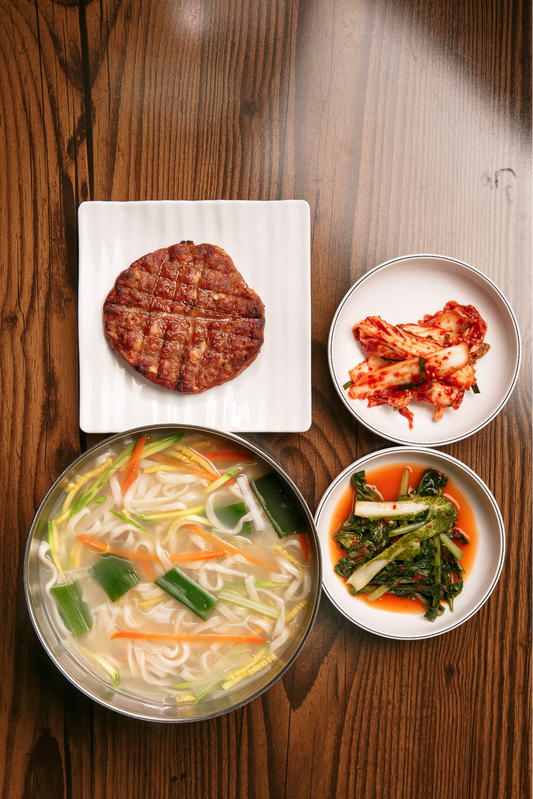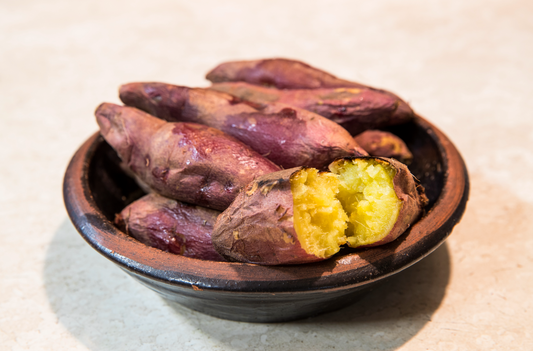Kimchi Pairing with Southeast Asian Cuisine: Hitsumabushi, Pad Thai, Tom Yum Goong, and Spring Rolls(Part1)

Can Korean kimchi boost the flavors of Southeast Asian food? Think about combining the smoky Hitsumabushi with the tang of kimchi. Or mixing the zesty Pad Thai and the heat of Tom Yum Goong with it. Even the fresh Vietnamese spring rolls can get a new twist. This guide shows how kimchi and Southeast Asian dishes blend to amaze our taste buds.
Kimchi is popular worldwide, but its mix with Southeast Asian food is something special. Picture Hitsumabushi's eel paired with kimchi's sharp taste. Or how kimchi lifts the sweet and sour notes of Pad Thai. Maybe the tangy touch of kimchi can spice up Tom Yum Goong's flavors. And think of kimchi's crunch against the softness of a spring roll. This guide will show you the power of combining kimchi with these flavors.
Key Takeaways
- Discover the art of balancing kimchi pairing with the rich flavors of Southeast Asian cuisine.
- Uncover the secrets of fusing fermented food and Southeast Asian cuisine for enhanced dining experiences.
- Learn practical tips from our kimchi pairing guide to complement a variety of dishes, from smoky eel to crisp spring rolls.
- Appreciate how Korean kimchi with Southeast Asian dishes can transcend cultural boundaries to deliver spectacular taste profiles.
- Find inspiration to create your own culinary masterpieces by embracing the versatility and depth that kimchi adds to beloved Southeast Asian recipes.

Hitsumabushi: The Rich Harmony of Eel Rice and Kimchi
The traditional Japanese dish, Hitsumabushi, mixes with the spicy Korean kimchi for a unique taste. Hitsumabushi kimchi harmony shows how the sweet grilled eel and kimchi's tangy flavors work well together. It's more than mixing foods; it's about creating a new culinary conversation between kimchi with Japanese dishes.
Korean kimchi is now a big part of Japanese cuisine. It adds a special touch to every bite with its fermented taste. The vivid flavor of kimchi complements the eel's rich, smoky hints, making Hitsumabushi even better. Whether it's on the eel or on the side, kimchi highlights the eel's subtle flavors.

The Taste and Characteristics of Hitsumabushi
Hitsumabushi is known for its savory and slightly sweet flavors. It's a standout dish in Japanese food. The dish is made from grilled eel with a special sauce. This gives a unique taste that's deep in tradition and very satisfying. The eel gets cooked until tender. Its rich taste is boosted by a smoky aroma from char-grilling.
Overview of the unique taste of grilled eel and its savory flavors
The way Hitsumabushi is prepared makes the eel's umami stand out. Umami is seen as a key taste in Japanese cooking. This richness sets Hitsumabushi apart from other eel dishes. Adding kimchi, with its tangy and spicy flavors, makes it even better. The hitsumabushi kimchi harmony adds a burst of flavor that lifts the eel’s natural taste.
When pairing kimchi with Hitsumabushi, it’s important to choose the right kind. You want a kimchi that adds to the dish without overpowering it. A well-fermented kimchi's spicy kick contrasts nicely with the eel's sweet sauce. This balance is not just tasty but also reflects Japanese tradition of mixing bold flavors.
Hitsumabushi is a prized dish, whether eaten in Tokyo or Kyoto. It offers a unique sensory journey through Japanese cuisine. Each serving shares a story of cultural heritage, careful craft, and the search for perfect flavor balance.
Flavor Balance Between Hitsumabushi and Kimchi
Japanese and Korean cuisines mix beautifully, especially when kimchi pairing is involved. It's seen clearly with Hitsumabushi. The combination enhances both taste and texture, making the meal more enjoyable.
How the spicy, tangy flavors of kimchi complement the rich umami of Hitsumabushi
Hitsumabushi is a savory dish from Nagoya, famous for its grilled eel. Adding kimchi introduces a spicy and tangy kick. This kimchi pairing adds complexity to the flavors, elevating the dish.
Kimchi's fermentation brings out the umami in the eel, creating a bold taste. Moreover, it adds a crunch to the soft eel, mixing textures beautifully.
As kimchi becomes popular worldwide, its use in Japanese dishes like Hitsumabushi is inspiring. This fusion highlights traditional and modern flavors, celebrating culinary innovation.

Tips and Recipe for Pairing Hitsumabushi with Kimchi
Exploring the hitsumabushi kimchi harmony is about trying different ways to add kimchi to Hitsumabushi. This elevates the classic grilled eel rice dish. One preferred method is to add finely chopped kimchi on top of the warm rice. This mixes its sharp, tangy taste with the eel's smokiness.
Tips for adding kimchi to Hitsumabushi for an enhanced flavor experience
To add kimchi's bright taste to Hitsumabushi without overpowering it, try pouring kimchi juice over it. This technique gives the eel a rich, fermented flavor, creating an enjoyable contrast. You can also serve kimchi on the side. This lets everyone adjust the taste as they like, making the meal more enjoyable for all.
In pursuit of perfect hitsumabushi kimchi harmony, these suggestions widen our taste horizons. They also stay true to the dishes' roots. This brings a new twist that is both interesting and delightful.

Pad Thai: The Balance of Sweet, Salty, and Spicy with Kimchi
Pad Thai is a famous dish from Thailand that mixes sweet, salty, and spicy tastes. It's a national favorite enjoyed worldwide in markets and restaurants. It includes rice noodles, eggs, tofu, leeks, peanuts, and bean sprouts. These are flavored with tamarind, sugar, fish sauce, vinegar, and chili pepper. Adding kimchi gives the dish an exciting tangy flavor.
Pad thai with kimchi not only adds a side but combines two rich food traditions. Kimchi's fiery taste works well with Pad Thai's sweet and salty nature. This mix creates a unique eating experience that showcases kimchi and Thai flavors together. For an extra twist, adding gochujang to the Pad Thai sauce can bring more depth and spice.
The love for kimchi with Thai dishes like Pad Thai comes from their flavorful balance. Enjoyed in busy markets or at home, Pad Thai with kimchi meets the craving for comforting yet bold tastes. This trend values traditional recipes while welcoming new combinations. It creates a meal that's as fulfilling as it is enjoyable.

The Unique Flavors of Pad Thai
Pad Thai is a celebrated dish in Thai cuisine, known for its perfect balance of sweet, salty, and tangy. Its foundation is rice noodles. They pair with shrimp or tofu for a flavorful dish. The sauce, with tamarind paste, palm sugar, and fish sauce, sets it apart from sweeter or ketchup-added versions.
Pad Thai thrives on blending new elements while staying true to its core. The addition of pad thai with kimchi has become popular. Kimchi adds a spicy and umami punch that fits well with the dish’s complex flavors.
A look at the blend of sweet, salty, and tangy flavors in Pad Thai
Premium Erawan Brand rice noodles provide the perfect base, avoiding soggy outcomes. Traditional Pad Thai’s success lies in its cooking method. Stir-frying quickly in a hot wok does wonders, releasing the flavors of shallots, garlic, dried shrimp, and tofu.
Cooking tips include focusing on the texture of bean sprouts and chives for crunch. When adding kimchi with Thai dishes, its sharpness cuts through the noodle's richness beautifully. Kimchi enhances the dish's zest and fits Thai food's flavor balance philosophy well. Adding kimchi juice to the cook brings new flavors to Pad Thai, perfect for those who love new tastes.
This spirit of culinary adventure makes Pad Thai more than a meal. It's an experience that delights the senses. It keeps evolving but honors its rich traditions.
Flavor Harmony Between Pad Thai and Kimchi
Pad Thai is a famous noodle dish from Thailand. It's known for its perfect mix of sweet, sour, and savory tastes. When you add kimchi, a key part of Korean food, the flavors become even more exciting. This mix is not just food magic but a great combination of tradition and flavor.
Kimchi, especially the type made from Napa cabbage, is loved for its lively taste and health perks. It helps with gut health. This makes it a great match for Pad Thai's deep flavors. Adding kimchi to the dish, or having it on the side, makes every bite more flavorful. The fermented tang of kimchi contrasts beautifully with the sweet noodles.
How the sharpness of kimchi enhances the vibrant flavors of Pad Thai
The tangy bite of kimchi enhances Pad Thai's flavors. It cuts through the dish's sweetness and adds an interesting texture. This combination is about mixing cultures as much as flavors. It improves the meal experience. The fermented taste of kimchi adds a fresh acidity. This complements the rich flavors of Pad Thai, following the kimchi pairing tips for flavor balance.
Kimchi is recognized by UNESCO for its cultural importance. Mixing it with Pad Thai does more than just taste good. It shows a respect for and blending of Korean and Thai food traditions. Each bite showcases the harmonious blend of these culinary arts.

Tips and Recipe for Pairing Pad Thai with Kimchi
Mixing pad thai with kimchi makes a regular meal thrilling. You can mix kimchi into Pad Thai or put it on the side. Here are some tips to make these flavors work well together.
Tips for Preparing Pad Thai with Kimchi
First, know how to make Pad Thai. Prep takes about 10 minutes and cooking, 5 to 7 minutes. Begin with tamarind paste from a 14 oz block of dried tamarind, dissolved in 14 fl oz of water. This gives you paste for the sauce in 20 minutes.
For the sauce, mix 3/4 cup fish sauce, 1 cup palm sugar, 1/4 cup light brown sugar, and 1/2 cup plus 2 tablespoons tamarind pulp. This makes enough for 3-4 people, creating a tasty sauce for your noodles.
Add chopped kimchi in the last two minutes of cooking Pad Thai. This warms the kimchi and adds a tangy flavor without too much. Or, put kimchi on the side to let everyone adjust the flavor. This way, it suits many tastes and makes the meal better.
Always remember that the key to a successful integration of kimchi is to respect both the traditional elements of the Pad Thai and the bold, sharp character of the kimchi.
In short, making pad thai with kimchi well is about finding the right balance. Kimchi can make ordinary Pad Thai special, whether it’s mixed in or a side. Use these kimchi pairing tips for a fun and fulfilling meal.








